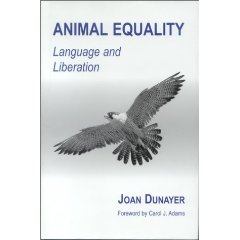On ANIMAL EQUALITY, by Joan Dunayer
 A handful Animal Person readers since May of 2006, when I started this then-daily blog, have asked me if I've read Joan Dunayer. And now that I've read Animal Equality and begun Speciesism, I think I know why.
A handful Animal Person readers since May of 2006, when I started this then-daily blog, have asked me if I've read Joan Dunayer. And now that I've read Animal Equality and begun Speciesism, I think I know why.
My deconstructions of the language of our relationship with sentient nonhumans in this blog–and the way I approach discussing that relationship–is similar to Dunayer's.
It's enjoyable reading someone with whom I feel closely aligned philosophically, though I do think that in practice–and for practical purposes–I'm probably less strict now than I once was with my language. I used to be a stickler for using "enslavement," "flesh," and other accurate descriptors. But I found that if my goal was for my message to be received, I had to judiciously use accurate terms because there was an intense emotional reaction to them that prevented the message from being received intact, or unadulterated by the emotional baggage. Put simply, many people just can't handle the truth–or too much of it at once.
Dunayer devotes a chapter each to the language used in hunting, zoos, "marine parks," vivisection and "animal agriculture." She also explores pronouns and metaphors, and she even offers style guidelines and a thesaurus of "Alternatives to Speciesist Terms." I haven't examined each institutionalized use of animals the way that Dunayer has, with the possible exception of vivisection, and I learned a lot about the details of the language of each industry.
Here are some of my favorite quotes:
- "Companion animal reduces a dog, cat, or other nonhuman to the role of companion. Minus that role, the term implies, such an animal has no place; if they aren't some human's companion, or their companionship fails to please, they can be abandoned or killed" (8). In the notes, she explains that she uses "nonhuman companion and nonhuman friend with reference to nonhumans treated with full respectl I use pet with reference to nonhumans who are sold, discarded, or otherwise disrespected" (204).
- "Field & Stream executive editor David Petzal defines fair chase as 'stalking an animal on its own terms.' An animal's own terms are 'Don't hunt me'" (49).
- "At a minimum, catching and releasing a fish inflicts pain, terror, and temporary disability. Often it permanently disables or kills . . . . Many fishes are released with a gaping hole where they were stabbed and held aloft for photos" (66).
- "Fishers who catch and release may kill more fishes than those who catch only the number they're legally allowed to keep. . . . If fishers truly wished to revitalize fish populations, they would leave them alone. Through semantic reversal, fishers (like hunters) pretend to promote rather than destroy life" (67).
- "Two tigers confined to a cage gave 'freedom' from enemies. . . . With equal validity, we could say that a human locked inside a room has 'freedom' from muggers" (75).
- "However young and healthy, captives judged inappropriate for exhibition or breeding are considered 'excess' and usually are 'unloaded' or killed. Each year, US zoos label thousands of nonhuman animals 'surplus' and treat them accordingly" (87).
- "Just as industry photos leave tank and pool borders invisible (giving the impression of open ocean), industry excludes words that signal harsh confinement. Sea World of Florida has directed its staff to replace tank with aquarium, and cage with enclosure" (94).
- "In their publications, vivisectors virtually never state that they inflicted the harm suffered by their victims. Instead, they hide behind passive verbs. Avoiding first-person pronouns, vivisectors report that cardiac arrest 'was produced' in puppies, rather than 'We gave puppies cardiac arrest'" (118).
- "By pairing humane with slaughter, legislators have sanctioned horrific cruelty and mass murder. What if slaughter were freed (miraculously) of all terror and pain? Like any other unnecessary killing of innocent beings, it still wouldn't be humane" (137).
- "Each year, 'food animals' suffer and die by the billions, but they do so one by one. To rest easy, those who buy or sell products from nonhuman bodies must forget that each victim suffered personal loss of freedom, well-being, and life" (140).
- "Using who for every creature with a nervous system avoids dismissing any sentient being. Overly generous inclusion? Perhaps. But I'd rather accord an insentient thing undue respect than slight any being who feels. I'd rather extend moral consideration to something that can't suffer than fail to extend it to someone who can" (154).
- "From trappers to vivisectors, humans guilty of torturing, enslaving, and murdering nonhuman beings retain freedom and life; their innocent victims do not" (175).
I could go on and on.
Though I didn't put Animal Equality on the list at Chance's GiveForward page (and here's more of the backstory), I will gladly send it to anyone who makes a donation. Chance is so close! Please consider a gift.




Oh how strange (their) language is made to be… Cows "give" milk… "We gave puppies cardiac arrest" – Everything's so happy, happy isn't it??? 🙁
But I do hope the best for Chance – Such a special dog…
Thanks for highlighting this book, as it has profoundly influenced my advocacy. The movement needs to take language seriously, since our language influences our own and others' perception of reality and has real consequences for nonhuman animals.
To help avoid language that fosters oppression and instead use language that liberates, Joan Dunayer has created a handout called "Avoiding Speciesist Terms":
http://files.meetup.com/1518190/Avoiding%20Speciesist%20Terms.pdf
I use this handout in my outreach with the grassroots abolitionist group I co-founded. It is eye-opening for most readers and helps spread the message of animal equality.